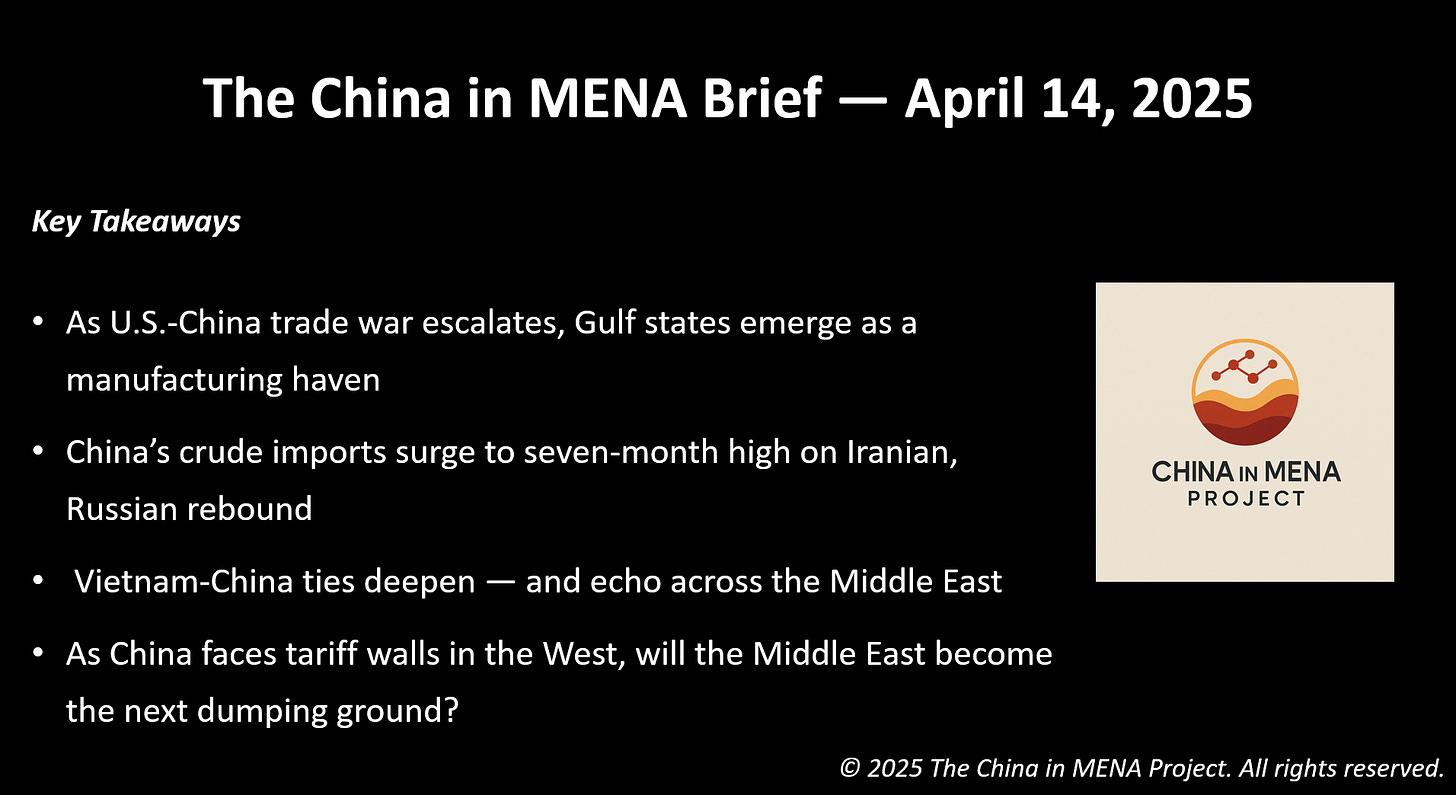The China in MENA Brief — April 14, 2025
Middle East Caught Between Demand and Dumping
1. As U.S.-China Trade War Escalates, Gulf States Emerge as a Manufacturing Haven
With the U.S. and China locked in a no-holds-barred trade war, manufacturers looking to dodge tariff crossfire may have found an unlikely safe haven: Saudi Arabia.
Energy-rich Gulf states stand to benefit as rising tariffs force companies to rethink supply chains. The Gulf’s appeal lies in its cheap energy, regulatory flexibility, and strategic neutrality.
Manufacturing is central to Crown Prince Mohammed bin Salman’s efforts to diversify the economy. In March, the kingdom reported a 13% year-on-year rise in non-oil exports (excluding re-exports). Yet oil still accounts for 87% of total exports.
The U.S.-China standoff could accelerate Riyadh’s industrial ambitions — by simultaneously depressing energy prices and undermining China’s export competitiveness.
Strategic Takeaways:
China’s Pivot Pressure: The Gulf could feel pressure too. As Chinese firms lose access to the U.S. market, the Middle East may be flooded with cheap goods — adding competitive tension to emerging Gulf industries.
Manufacturing Moonshot: While building industrial infrastructure takes time, Saudi Arabia has the capital, the land, and a leadership willing to fast-track transformation — especially with U.S. trade allies in search of alternatives.
Energy Edge: With some of the cheapest energy on the planet, Saudi Arabia offers a compelling cost advantage for energy-intensive sectors like petrochemicals and aluminum.
2. China’s Crude Imports Surge to Seven-Month High on Iranian, Russian Rebound
China’s crude oil imports jumped sharply in March, snapping a two-month slowdown and marking the strongest inflow since August 2023, driven by a surge in Iranian barrels and a rebound in Russian shipments.
According to data released Monday by the General Administration of Customs, China imported 51.41 million metric tons of crude last month, equivalent to 12.1 million barrels per day. That’s up nearly 5% year-on-year and the highest monthly volume in over half a year, Reuters data shows.
The rebound highlights how key shadow suppliers — particularly Iran and Russia — are regaining momentum despite ongoing geopolitical pressures and sanctions risk.
Strategic Takeaways:
Iran Fills the Gaps: A surge in Iranian oil is propping up Chinese imports. Despite U.S. sanctions, Tehran appears to be moving barrels via non-blacklisted vessels and alternative channels — signaling continued enforcement challenges.
Russia Ramps Back Up: Russian deliveries also saw a bounce, suggesting China’s refiners are continuing to prioritize discounted barrels over Western supply routes, even amid secondary sanctions risks.
Record-Breaking Appetite: At 12.1 million bpd, China’s March import volume marks its highest since August — underlining its ongoing role as a demand engine in the global oil market.
3. Vietnam-China Ties Deepen — and Echo Across the Middle East
As Xi Jinping prepares to mark the 75th anniversary of China-Vietnam diplomatic ties with a state visit to Hanoi, Beijing’s rhetoric around “shared futures” is resonating far beyond Southeast Asia — including across the Middle East.
Xi’s remarks cast the China-Vietnam relationship as a model of socialist partnership, industrial alignment, and multilateral cooperation in the Global South. But it seems to be a blueprint that is increasingly visible in China’s broader foreign policy — from Hanoi to Baghdad.
Strategic Takeaways:
Ideological Soft Power: In Vietnam, China frames cooperation in terms of “shared revolutionary traditions” and socialist modernization. In the Middle East, where political models differ, the appeal is more pragmatic — centered on sovereignty, economic multipolarity, and non-interference. But the message of alternatives to Western liberalism resonates across both regions.
People-to-People and Digital Ties: Xi's call for greater youth, tourism, and cultural exchanges with Vietnam echoes Chinese soft power initiatives in the Middle East — from language institutes and film festivals to rising interest in Arabic-Chinese academic partnerships and tourism corridors.
Global South as Strategic Axis: Xi’s “community with a shared future for mankind” isn’t just rhetoric — it’s being actively implemented through platforms like the Global Development Initiative (GDI) and Global Security Initiative (GSI). For many Middle Eastern nations, especially Gulf states navigating between U.S. security ties and Chinese economic outreach, these frameworks offer a non-Western model of cooperation centered on sovereignty, infrastructure, and multipolar diplomacy. As Southeast Asia aligns through BRI corridors, the Middle East is emerging as the western anchor of China’s Global South strategy, linking ports, energy, and strategic industries into Beijing’s evolving global architecture.
4. As China Faces Tariff Walls in the West, Will the Middle East Become the Next Dumping Ground?
With the U.S. slapping steep new tariffs on Chinese goods and Europe bracing for a potential flood of low-cost exports, global trade tensions are entering a volatile new phase. While the spotlight is on the transatlantic fallout, it is possible that the Middle East could quietly become the next pressure valve for China's industrial overcapacity.
A recent article in The New York Times paints a stark picture: Europe, long wary of China’s economic model, now fears an “economic disaster” as Chinese manufacturers, cut off from American buyers, look for new export markets. In response, the EU is establishing a task force to monitor for dumping and has issued warnings about overcapacity and illegal subsidies.
But unlike Europe, Middle Eastern countries have no comparable trade defense mechanisms — and that makes them vulnerable.
Strategic Takeaway:
The article paints a picture of Europe bracing against a flood of Chinese overcapacity. But in the Middle East — where open markets and fast-track industrial growth are the norm — the risk may be even sharper. Lacking Brussels-style trade defenses or coordinated policy tools, Gulf economies could become unwitting landing zones for China’s redirected exports.
The next move requires clarity — and speed: either absorb the surplus passively, or craft a focused industrial strategy that dictates how, when, and on whose terms Chinese capital and goods enter the regional market.
© 2025 The China in MENA Project. All rights reserved.
Newsletter every Monday & Friday ( X: @chinainmena)
Founder/Manager Zineb Riboua ( X: @zriboua)
Contact: riboua@chinainmena.com




Good article